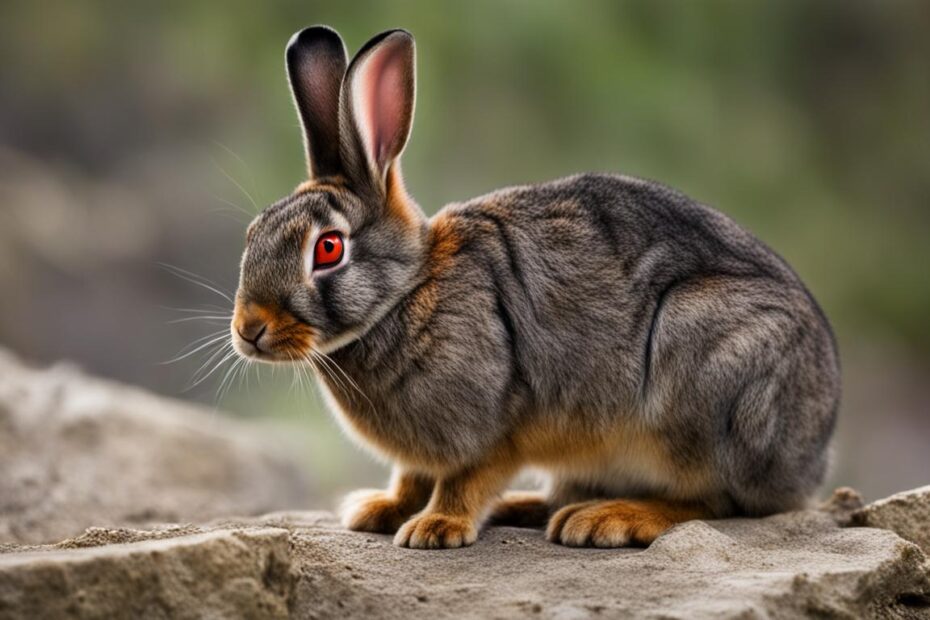Red-eyed rabbits are a captivating sight that never fails to catch attention. Their unique eye color is the result of a genetic mutation known as albinism. These rabbits, with their striking appearance, have completely colorless fur and vivid red eyes. While albinism is rare in the wild, certain rabbit breeds have been selectively bred to always have red eyes.
Discovering more about red-eyed rabbits and their intriguing genetic makeup can deepen our understanding of these captivating creatures. Let’s delve into the fascinating world of red-eyed rabbits and uncover the secrets behind their extraordinary eye color.
Key Takeaways:
- Red-eyed rabbits have a genetic mutation known as albinism.
- Albinism disrupts the production of melanin, resulting in white fur and red eyes.
- Certain rabbit breeds, such as the Himalayan, Florida White, and Californian, always have red eyes.
- Red-eyed rabbits require special care due to their poor eyesight and sensitivity to light.
- Albino rabbits can be wonderful pets with proper care and attention.
Which Rabbits Have Red Eyes
Understanding Albinism in Rabbits
Albinism is a fascinating genetic condition that affects the eye color of rabbits. It occurs when there is a disruption in the production of melanin, the pigment responsible for coloration in a rabbit’s eyes and fur. In albino rabbits, the absence or mutation of the gene responsible for melanin production leads to white fur and red eyes. This lack of pigmentation in their eyes causes the reflection of light off their blood vessels, resulting in the striking red eye color.which rabbits have red eyes
Albinism is an inherited trait in rabbits and follows a recessive pattern. This means that both parents must carry the albino gene for it to be expressed in their offspring. Breeders can selectively breed rabbits with the albino gene to produce red-eyed white rabbits. However, it is important to note that albinism can also occur sporadically in rabbits without a known family history of the condition.
“Albinism is a fascinating genetic condition that affects the eye color of rabbits.”
It is worth mentioning that the red eye color in rabbits is not limited to pure albino rabbits. Other rabbit breeds may occasionally exhibit red eyes due to the presence of the albino gene. While the Himalayan, Florida White, and Californian breeds are known for always having red eyes, breeds such as Angora, Britannia Petite, Flemish Giant, Holland Lop, Jersey Wooly, Lionhead, Mini Lop, Netherland Dwarf, New Zealand, Polish, Rex, and Satin rabbits may also display this eye color. However, the occurrence of red eyes in these breeds can vary. rabbit breeds with red eyes
| Rabbit Breed | Red Eye Color |
|---|---|
| Himalayan | Always |
| Florida White | Always |
| Californian | Always |
| Angora | Occasionally |
| Britannia Petite | Occasionally |
| Flemish Giant | Occasionally |
| Holland Lop | Occasionally |
| Jersey Wooly | Occasionally |
| Lionhead | Occasionally |
| Mini Lop | Occasionally |
| Netherland Dwarf | Occasionally |
| New Zealand | Occasionally |
| Polish | Occasionally |
| Rex | Occasionally |
| Satin | Occasionally |
Understanding the genetics and characteristics of red-eyed rabbits is crucial for rabbit enthusiasts and breeders alike. It allows for the appreciation of the unique traits exhibited by these fascinating creatures and ensures proper care and management to promote their well-being.red-eyed rabbit genetics
Care Considerations for Red-Eyed Rabbits
Red-eyed rabbits can make unique and fascinating pets, but they require special care due to their genetic condition of albinism. It’s important to consider their specific needs when providing a safe and nurturing environment.
Poor eyesight: Albino rabbits may have poorer eyesight compared to non-albino rabbits. This is due to the absence of pigmentation in their eyes, which affects the development of the iris and retina. As a result, red-eyed rabbits may take more time to scan their surroundings and navigate their environment. It’s essential to create a safe and secure living space for them, minimizing potential hazards and providing plenty of space to explore.inherited red eye trait in rabbits
Sensitive to light: Red-eyed rabbits are more sensitive to light because of their lack of iris pigmentation. Exposure to bright sunlight can cause discomfort and potential eye damage. To protect their eyes, provide ample shelter and shade in their living area. This can include providing access to a covered enclosure or ensuring that their hutch or cage is positioned in a shaded area.
Grooming: Red-eyed rabbits may have slightly more visibly stained fur compared to rabbits with darker eyes. This is because tears and other secretions may leave more visible marks on their lighter fur. It’s important to regularly groom red-eyed rabbits to keep their fur clean and free from matting. This can involve brushing their fur gently with a soft brush or comb and wiping their eyes with a damp cloth to remove any discharge.red-eyed rabbits as pets
| Special Care Considerations for Red-Eyed Rabbits | |
|---|---|
| Poor eyesight | Albino rabbits may have poorer eyesight compared to non-albino rabbits. They may take more time to scan their surroundings. |
| Sensitive to light | Red-eyed rabbits are more sensitive to light and can experience discomfort and potential eye damage. Provide ample shelter and shade for them. |
| Grooming | Red-eyed rabbits may have slightly more visibly stained fur. Regular grooming is necessary to keep their fur clean and free from matting. |
By understanding and addressing these care considerations, you can provide a loving and supportive environment for your red-eyed rabbit. Remember to consult with a veterinarian experienced in rabbit care to ensure that you are meeting all of their specific needs and to address any potential health concerns that may arise.
Red Eye Color in Other Rabbit Breeds
While the Himalayan, Florida White, and Californian are the only recognized rabbit breeds that always have red eyes, there are other breeds that can occasionally have red eyes due to the presence of the albino gene. These breeds include Angora rabbits, Britannia Petite, Flemish Giant, Holland Lop, Jersey Wooly, Lionhead, Mini Lop, Netherland Dwarf, New Zealand, Polish, Rex rabbits, and Satin Rabbits. However, the presence of red eyes in these breeds may vary.determining eye color in rabbits
It’s important to note that not all individuals in these breeds will have red eyes, as the expression of the albino gene can vary. Some rabbits may have only one red eye, while others may have both eyes red. The occurrence of red eyes in these breeds often depends on the specific genetics and breeding practices of the individual rabbit. Breeders who aim to produce red-eyed rabbits will selectively pair rabbits with the albino gene to increase the likelihood of offspring with red eyes.
When considering adopting a rabbit with red eyes from one of these breeds, it’s essential to research the specific breed and individual rabbit to understand the likelihood of red eye color. It’s also important to note that red-eyed rabbits may require additional care due to their sensitivity to light. Providing ample shade and protecting them from direct sunlight can help ensure their well-being.
| Breed | Possibility of Red Eyes |
|---|---|
| Angora | Possible |
| Britannia Petite | Possible |
| Flemish Giant | Possible |
| Holland Lop | Possible |
| Jersey Wooly | Possible |
| Lionhead | Possible |
| Mini Lop | Possible |
| Netherland Dwarf | Possible |
| New Zealand | Possible |
| Polish | Possible |
| Rex | Possible |
| Satin | Possible |
“Not all individuals in these breeds will have red eyes, as the expression of the albino gene can vary.”
The Range of Eye Colors in Rabbits
While red eyes are a distinctive feature of albino rabbits, rabbits can actually have various eye colors. The most common eye color is brown, but rabbits can also have blue or even pink eyes. Pink eyes are not the same as red eyes in albino rabbits and are caused by a specific set of genes that give the iris a pale pink appearance. Marbled eyes, where the iris is two or more separate colors, can also occur in rabbits.
In addition to the more common eye colors, there are some unusual eye colors that can be found in rabbits as well. Some rabbits may have green or hazel eyes, which can add a unique touch to their appearance. These eye colors are less common than brown, blue, or pink, but they can still be found in certain rabbit breeds.
“Rabbits are known for their expressive eyes, and the range of eye colors adds to their individuality and charm,” says Dr. Jane Thompson, a veterinarian specializing in exotic pets. “It’s important for rabbit owners to pay attention to their pet’s eye health and seek veterinary care if they notice any abnormalities or changes in eye color.”
As with any living creature, eye color in rabbits is determined by genetics. Different combinations of genes can result in variations in eye color, just like in humans. The specific genes responsible for eye color in rabbits are still being studied, but researchers believe that multiple genetic factors contribute to the wide range of eye colors observed in different rabbit breeds.
| Rabbit Breed | Common Eye Color |
|---|---|
| Dutch | Brown, Blue |
| Flemish Giant | Brown, Blue |
| Jersey Wooly | Brown, Blue |
Health Concerns for Red-Eyed Rabbits
While red-eyed rabbits are captivating creatures, their unique genetic makeup can make them more prone to certain health problems. Understanding these potential issues and taking proactive measures can help ensure the well-being and longevity of red-eyed rabbits.
Potential Health Problems:
- Red Eye Infection: Red-eyed rabbits are susceptible to eye infections, also known as hyperemia. These infections can be caused by allergies, bacterial or fungal infections, dental issues, or underlying health conditions.
- Poor Eyesight: Albino rabbits may have poorer eyesight compared to their non-albino counterparts. This can result in slower movement and more cautious behavior as they carefully navigate their surroundings.
- Sensitivity to Light: The absence of an iris in red-eyed rabbits makes them more sensitive to light. It is important to provide shelter and shade to protect their eyes from excessive brightness.
If you notice any signs of red eye infection in your rabbit, such as redness, discharge, or excessive blinking, it is crucial to seek veterinary care. A veterinarian can diagnose the underlying cause of the infection and provide appropriate treatment.
Additionally, regular check-ups with a knowledgeable veterinarian are essential for monitoring the overall health of red-eyed rabbits. Maintaining a clean living environment, providing a balanced diet, and ensuring proper grooming can also contribute to their overall well-being.
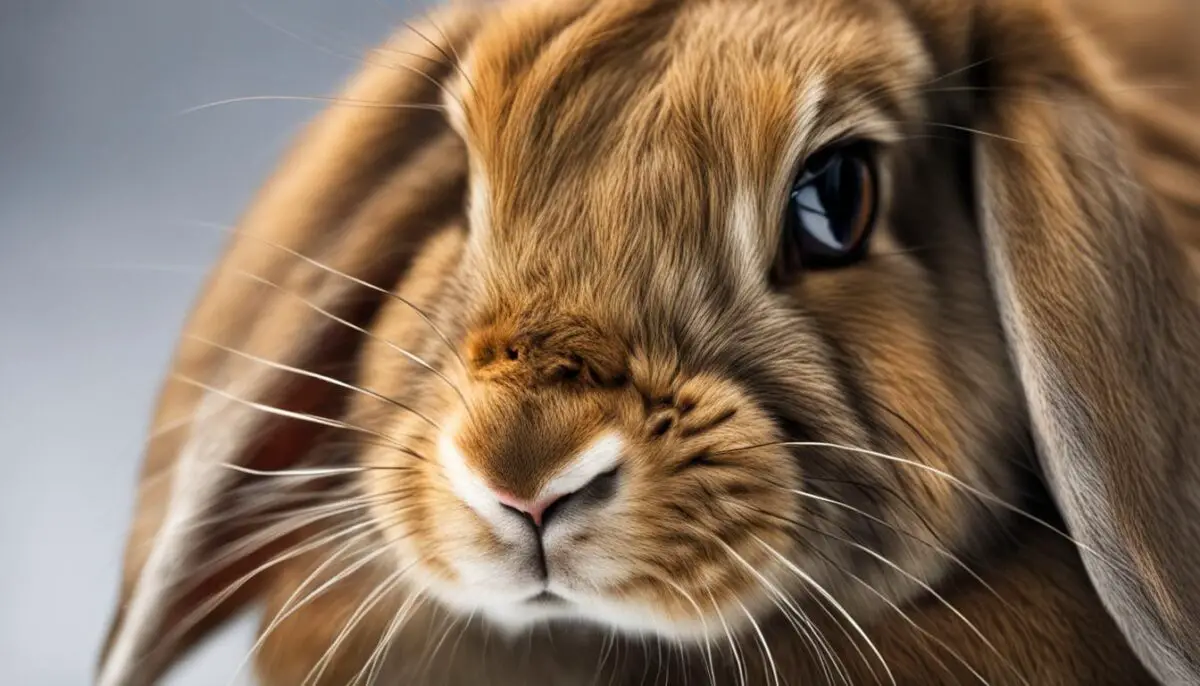
Table: Common Health Concerns for Red-Eyed Rabbits
| Health Concern | Symptoms | Treatment |
|---|---|---|
| Red Eye Infection (Hyperemia) | Redness, discharge, excessive blinking | Consult with a veterinarian for diagnosis and appropriate treatment |
| Poor Eyesight | Slow movement, cautious behavior | Provide a safe and familiar environment, minimize obstacles |
| Sensitivity to Light | Squinting, avoidance of bright areas | Provide shelter and shade, limit exposure to bright light |
Albinism in Wild and Domesticated Rabbits
Albinism is a rare occurrence in wild rabbits due to the increased visibility it brings, making them more vulnerable to predators. However, through the process of domestication, humans have intentionally bred albino rabbits, resulting in specific breeds that consistently exhibit the albino gene and have red eyes. Domesticated albino rabbits have become beloved pets for many people, thanks to their unique appearance and gentle personalities.
“The domestication of albino rabbits has allowed for the intentional breeding of these captivating creatures, resulting in specific breeds that always exhibit the albino gene and have red eyes.”
Unlike their wild counterparts, domesticated albino rabbits can be kept safe and protected from predators, allowing them to live happy and fulfilling lives in a controlled environment. The intentional breeding of albino rabbits has also led to the development of different rabbit breeds that consistently produce offspring with the albino gene.
While the presence of albinism in wild rabbits remains rare, the domestication of albino rabbits has created a population that continues to captivate and enchant rabbit enthusiasts around the world.
Table: Albino Rabbits in the Wild vs. Domesticated Albino Rabbits
| Wild Albino Rabbits | Domesticated Albino Rabbits |
|---|---|
| Extremely rare due to increased visibility to predators | Bred intentionally by humans for the albino gene |
| Live in the wild with limited protection | Kept as pets in safe and controlled environments |
| Subject to natural selection and survival challenges | Enjoy the benefits of selective breeding and care |
| Significantly limited presence and distribution | Breeds consistently produce offspring with the albino gene |
Through the process of domestication, humans have been able to transform the rarity of albino rabbits in the wild into a thriving population of domesticated red-eyed white rabbits. These unique creatures continue to capture the hearts of their owners, showcasing the beauty and wonder of the natural world in a controlled and safe environment.
The Unique Appeal of Albino Rabbits as Pets
Albino rabbits often face challenges in adoption due to misconceptions and prejudices surrounding their appearance. However, these red-eyed white rabbits can make wonderful pets. They are known for their docile and gentle personalities, and with proper care and attention, they can live happy and healthy lives. Educating potential adopters about the unique needs and characteristics of albino rabbits can help increase their chances of finding forever homes.
One common misconception about albino rabbits is that they are more prone to aggression or health issues. While it’s true that albino rabbits may have poorer eyesight and be more sensitive to light, these challenges can be easily managed with proper care. Providing a safe and comfortable environment with ample shade and shelter is essential for their well-being. Additionally, regular veterinary check-ups and a balanced diet will ensure that they stay healthy and thrive.
Albino rabbits can bring joy and companionship to their owners, just like any other rabbit. It’s important to look beyond their unique appearance and understand their specific needs. By providing a loving and supportive environment, albino rabbits can become cherished members of the family.
When considering adopting an albino rabbit, it’s crucial to understand that their red eyes are a result of albinism, a genetic condition that disrupts the production of melanin. This means that they lack pigmentation in their eyes and fur, resulting in their striking appearance. However, their red eyes do not affect their behavior or ability to form deep bonds with their human companions.
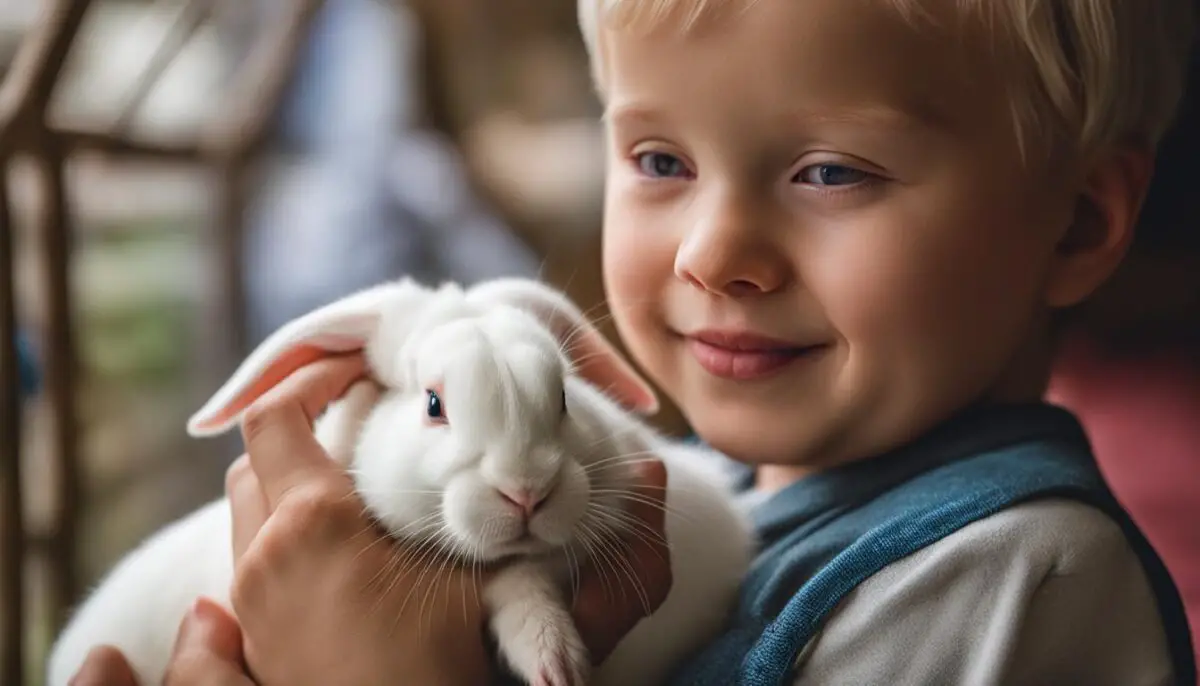
By dispelling misconceptions about albino rabbits and highlighting their unique appeal, we can help these beautiful creatures find the loving homes they deserve. Their gentle nature, captivating appearance, and the opportunity to provide specialized care can make adopting an albino rabbit a truly rewarding experience. Let’s give these red-eyed white rabbits the chance to thrive and be cherished as cherished pets.
Caring for an Albino Rabbit as a Pet
Albino rabbits require special care due to their sensitivity to sunlight and potential eye health concerns. Here are some essential care tips for albino rabbits:
- Provide ample shade and shelter: Albino rabbits are more susceptible to sunburn and eye damage from UV rays. Ensure they have access to shaded areas and shelter where they can seek protection from direct sunlight.
- Apply sunscreen: Use a baby-safe sunscreen with a high SPF on the ears and other exposed areas of your albino rabbit’s skin. This can help protect against sunburn and reduce the risk of skin cancer.
- Regular veterinary check-ups: Schedule regular visits to the veterinarian to monitor your albino rabbit’s overall health, including their eyes. Your vet can provide guidance on specific care needs and catch any potential eye issues early on.
- Proper nutrition: Feed your albino rabbit a balanced diet consisting of hay, fresh vegetables, and high-quality rabbit pellets. Good nutrition is essential for maintaining their overall well-being, including their eye health.
- Environmental enrichment: Provide your albino rabbit with mental and physical stimulation through toys, tunnels, and opportunities for exercise. This can help prevent boredom and promote a healthy, happy lifestyle.
Remember, each albino rabbit is unique, and their care requirements may vary. Observe your rabbit’s behavior and consult with a veterinarian experienced in rabbit care for personalized advice.
Quote:
“Albino rabbits require extra protection from sunlight due to their lack of pigmentation. Providing shade, sunscreen, and regular veterinary check-ups are essential to ensure their well-being.”
By following these care tips, you can help protect your albino rabbit from the harmful effects of sunlight and promote their overall health and happiness.
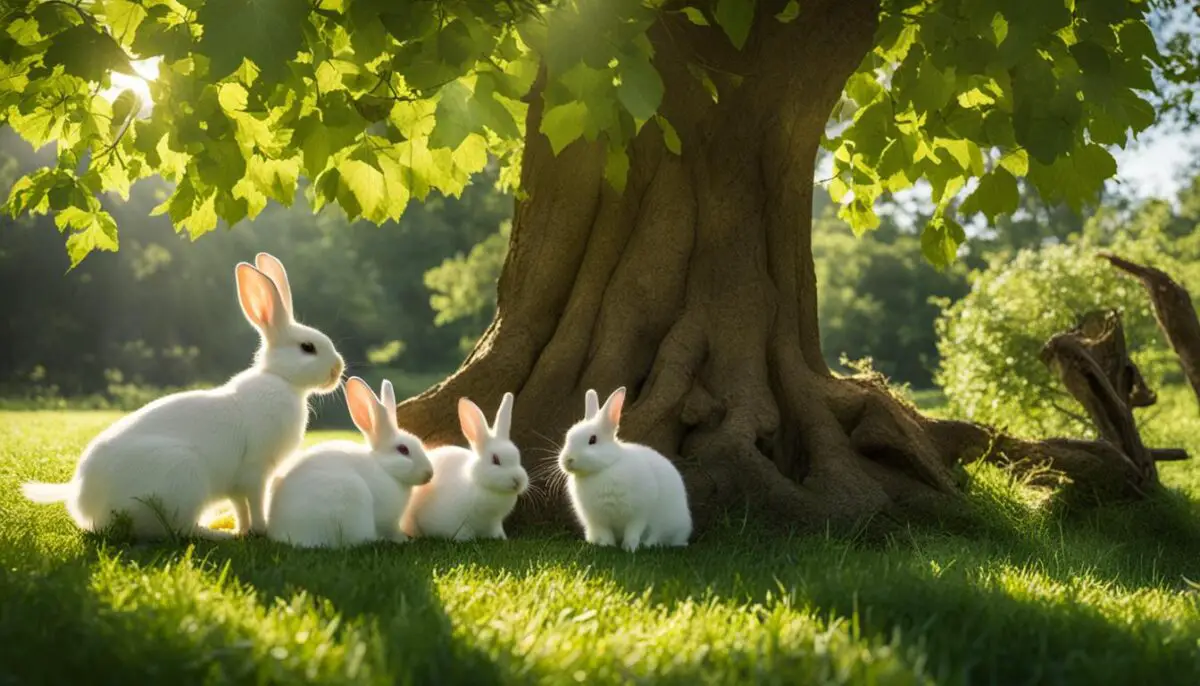
Breeding Considerations for Albino Rabbits
Breeding albino rabbits requires careful consideration of their genetics and potential health risks. As mentioned earlier, albino rabbits have a dominant albino gene, which means that breeding an albino rabbit with a non-albino rabbit can produce offspring with the albino trait. However, breeding two albino rabbits together is not recommended, as it can increase the chances of genetic health issues in the offspring.
Understanding the genetics of red-eyed rabbits is crucial when breeding. It is important to have a thorough understanding of dominant and recessive traits, as well as any potential health risks associated with certain gene combinations. Consulting with a veterinarian or a rabbit geneticist can provide valuable insights and guidance when it comes to breeding albino rabbits.
“Breeding albino rabbits requires careful consideration of their genetics and potential health risks.”
It is also important to prioritize the overall health and welfare of the rabbits when breeding. This includes ensuring that both the male and female rabbits are in good health, free from any underlying genetic or health issues that could be passed on to the offspring. Regular veterinary check-ups and genetic testing can help identify any potential risks and ensure that the breeding process is done responsibly.
Additionally, it is important to have a plan in place for the care and rehoming of the offspring. Responsible breeders should have a network of potential adopters or be prepared to provide lifelong care for the rabbits they breed. This helps prevent overpopulation and ensures that the rabbits have a safe and loving home.
The table below summarizes the main breeding considerations for albino rabbits:
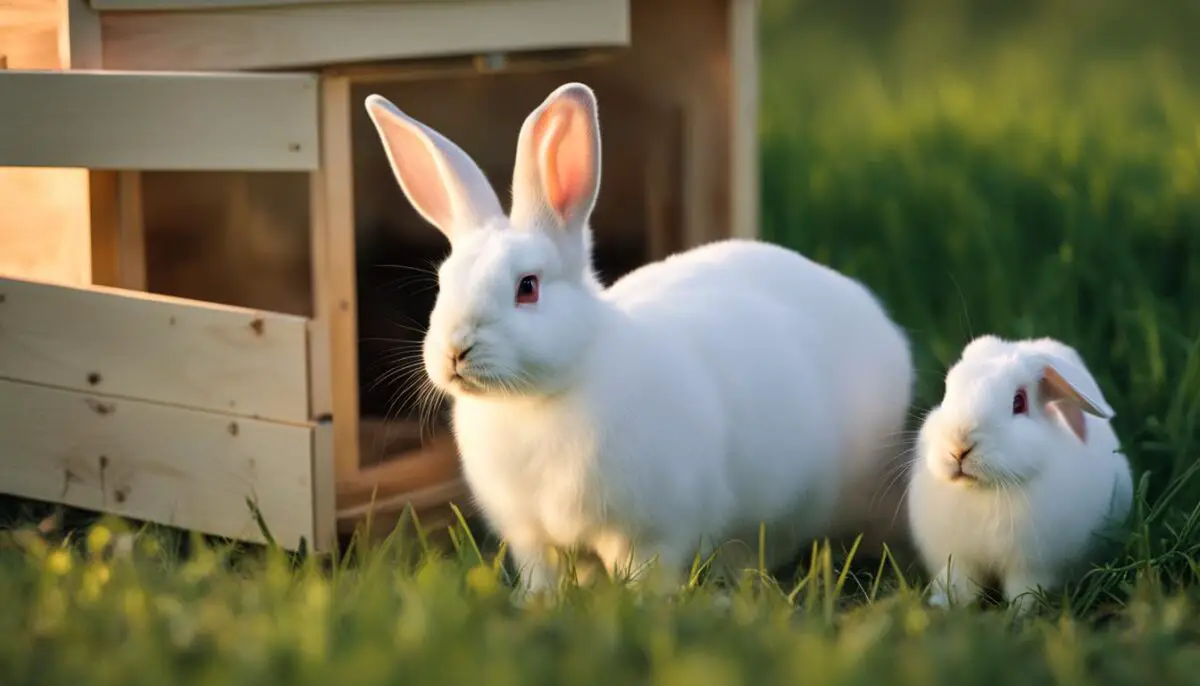
| Consideration | Description |
|---|---|
| Genetics | Understanding dominant and recessive traits in albino rabbits and potential health risks. |
| Health | Prioritizing the overall health of the breeding rabbits and potential genetic testing. |
| Responsibility | Having a plan for the care and rehoming of the offspring. |
Eye Health Concerns for All Rabbits
Rabbits are prone to various eye health problems, and it is essential for owners to be aware of these common conditions to ensure the well-being of their furry companions. Regular veterinary check-ups and proactive eye care can help prevent and treat these issues. Here are some eye health concerns that all rabbit owners should be familiar with:
Cataracts:
Cataracts are a common eye condition in rabbits, characterized by the clouding of the lens. This can cause blurred vision and, in severe cases, blindness. Cataracts can be hereditary or develop due to aging, trauma, or underlying health conditions. Regular monitoring by a veterinarian is important to detect and manage cataracts early on.
Teary Eyes:
Rabbits can experience excessive tearing, which may be a sign of underlying health issues or eye irritants. Common causes include allergies, infections, or obstructed tear ducts. Proper hygiene and regular cleaning around the eyes can help prevent tear stains and reduce the risk of eye infections.
Blocked Tear Ducts:
Blocked tear ducts can occur in rabbits, leading to excessive tearing and eye discharge. This condition can be caused by infections, foreign objects, or anatomical abnormalities. Gentle cleaning and warm compresses can help alleviate symptoms, but if the problem persists, veterinary intervention may be necessary.
Abscesses:
Abscesses around the eyes can develop in rabbits as a result of dental issues, infections, or injuries. These pus-filled pockets can cause discomfort, swelling, and discharge. Prompt veterinary attention is crucial to diagnose the underlying cause and provide appropriate treatment, which may include draining the abscess and administering antibiotics.
| Eye Health Concerns | Symptoms | Treatment |
|---|---|---|
| Cataracts | Cloudy lens, blurred vision | Regular monitoring, potential surgery |
| Teary Eyes | Excessive tearing, eye irritation | Cleanliness, reduce irritants |
| Blocked Tear Ducts | Excessive tearing, eye discharge | Cleaning, warm compresses, veterinary intervention |
| Abscesses | Swelling, discharge | Veterinary attention, draining, antibiotics |
Proper eye care and regular veterinary check-ups are crucial for maintaining the eye health of rabbits. Prompt detection and treatment of eye issues can help prevent more severe complications and ensure that rabbits enjoy a happy and healthy life.
Conclusion
In conclusion, red-eyed rabbits are a fascinating subset of the rabbit world, with their unique appearance and genetic makeup. Whether they are albino rabbits with red eyes due to a lack of pigmentation or rabbits with red eyes caused by an infection or other factors, understanding their specific care requirements is important for their well-being.
Red-eyed rabbits, particularly albino rabbits, may have poorer eyesight and be more sensitive to light. Providing them with shelter and shade is crucial to ensure their comfort. Additionally, regular grooming can help address any visible staining in their fur. It’s also important to be aware of potential health concerns, including red eye infections, and seek veterinary care when needed.
Despite some misconceptions, albino rabbits make wonderful pets. They are known for their docile and gentle personalities, and with proper care and attention, they can live happy and healthy lives. By providing a loving and supportive environment, albino rabbits can thrive and bring joy to their owners.
In summary, whether you’re considering adopting an albino rabbit or caring for a rabbit with red eyes, the key takeaways are to provide ample shade and shelter, seek veterinary care when necessary, and educate yourself about their specific needs. By doing so, you can ensure the well-being and happiness of these captivating creatures.
FAQ
Which rabbit breeds have red eyes?
The Himalayan, Florida White, and Californian rabbit breeds always have red eyes. Other rabbit breeds can occasionally have red eyes due to the presence of the albino gene, such as Angora rabbits, Britannia Petite, Flemish Giant, Holland Lop, Jersey Wooly, Lionhead, Mini Lop, Netherland Dwarf, New Zealand, Polish, Rex rabbits, and Satin Rabbits.
What causes red eyes in rabbits?
Red eyes in rabbits are caused by a genetic mutation known as albinism, which disrupts the production of melanin, the pigment responsible for color in a rabbit’s eyes and fur. The absence or mutation of the gene responsible for melanin production results in white fur and red eyes.
Do red-eyed rabbits require special care?
Red-eyed rabbits require the same basic care as any other rabbit. However, they may have poorer eyesight and be more sensitive to light due to albinism. Providing shelter, shade, and regular grooming can help meet their specific needs.
Can rabbits have different eye colors?
Yes, rabbits can have different eye colors. The most common eye color is brown, but rabbits can also have blue or even pink eyes. Pink eyes are not the same as red eyes in albino rabbits and are caused by a different set of genes that give the iris a pale pink appearance. Marbled eyes, where the iris is two or more separate colors, can also occur in rabbits.
Can red-eyed rabbits experience eye problems?
Yes, while red eyes are a distinctive feature of albino rabbits, all rabbits can experience eye problems. Common eye conditions in rabbits include cataracts, teary eyes, blocked tear ducts, and abscesses. Regular veterinary check-ups and proper eye care are important for the overall well-being of rabbits.
Are albino rabbits rare in the wild?
Yes, albino rabbits are rare in the wild due to their lack of pigmentation, which makes them more visible to predators. Domesticated rabbits, on the other hand, have been selectively bred for albino traits to produce red-eyed white rabbits.
Are albino rabbits suitable as pets?
Yes, albino rabbits can make wonderful pets. They are known for their docile and gentle personalities. Educating potential adopters about their unique needs and characteristics can help increase their chances of finding forever homes.
What care considerations are important for albino rabbits?
Providing shade, shelter, and protection from sunlight is important for albino rabbits due to their sensitivity to light. Regular veterinary check-ups, proper nutrition, and environmental enrichment are also essential for their well-being.
Can albino rabbits be bred?
Yes, breeding albino rabbits can result in offspring with the albino gene, as it is a dominant trait. However, breeding two albino rabbits together is not recommended due to the increased risk of genetic health issues.
Do all red-eyed rabbits have albinism?
No, while red eyes are a distinctive feature of albino rabbits, rabbits can have red eyes due to other factors, such as infections or specific genetic traits.
What are some common eye conditions in rabbits?
Common eye conditions in rabbits include cataracts, teary eyes, blocked tear ducts, and abscesses. These conditions may be symptomatic of underlying health issues and should be addressed by a veterinarian.


